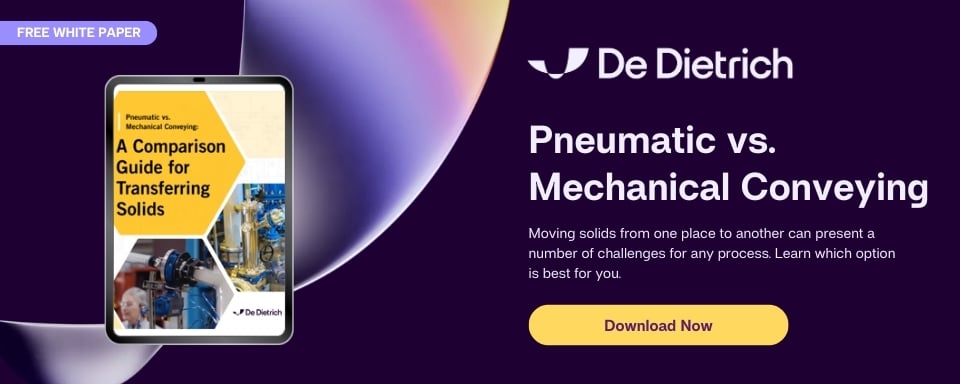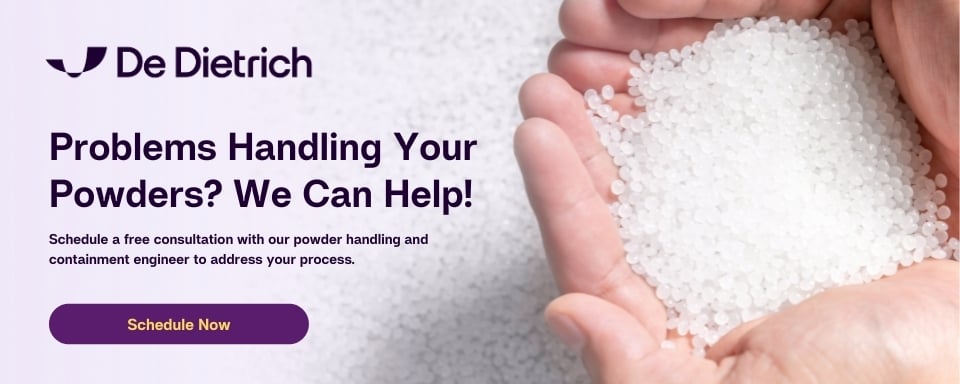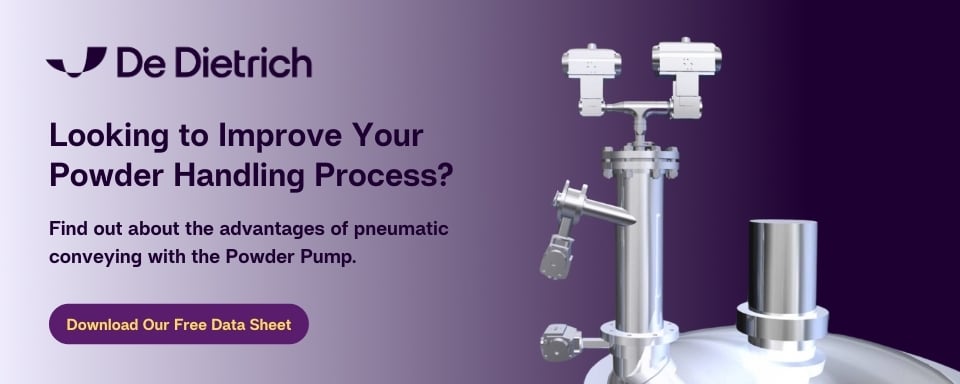How Pneumatic Conveying can improve the Cleanliness of your Facility
 Cleanliness in the workplace is crucial in pharmaceutical, fine chemical, food, and other industrial manufacturing sectors that rely on sanitary work conditions to uphold the integrity of their product. Furthermore, the cleanliness of a facility and its equipment directly affect productivity, which is a key factor in determining profitability.
Cleanliness in the workplace is crucial in pharmaceutical, fine chemical, food, and other industrial manufacturing sectors that rely on sanitary work conditions to uphold the integrity of their product. Furthermore, the cleanliness of a facility and its equipment directly affect productivity, which is a key factor in determining profitability.
Cleaning procedures can often be time consuming, creating unwanted downtime in the process and excessive labor that both play a role in a system’s overall efficiency. Even when best practices are put in place, there can still be a considerable number of issues in cleanliness if the powder in the process is not being transferred in a contained way. Aside from the health and safety issues that arise during this procedure, there is a huge potential for material to spill or be dropped, creating an unsafe, hazardous working environment filled with dust. Housekeeping issues like this can actually decrease the life expectancy of equipment due to the increased instance of external corrosion.
Pneumatic conveying via a closed system can help your process operate in a way that eliminates exterior contaminants, preserves the hygienic environment of your process, and extends the life of your existing equipment, all while efficiently, reliably, and safely transferring your powder from one location to another. Here are the benefits of pneumatic conveying regarding plant and equipment cleanliness:
Much easier to clean than manual transfer or mechanical conveying
It is a common practice to manually transfer material into a vessel. Surprisingly this occurs in some of the most modernized workplaces. This involves operators lifting and dumping containers of powder directly into the reactor. With mechanical equipment there is more automation involved, but the cleaning of conveyor belts poses a constant problem that is difficult to solve due to particles adhering to the belt as well as material build-up on the rollers. Most pneumatic conveyor designs, on the other hand, enable easy access to the filter design for cleaning, inspection and change out. Whether it is housekeeping requirements for sanitation or general cleaning between batches, pneumatic transfer systems need less maintenance and offer a cleaner way to transfer than manual and mechanical methods.
Closed system provides a dust-free environment
A closed system, meaning a system that prevents the product from becoming airborne and entering the environment, will substantially reduce equipment and facility clean-up time. Since less labor is required to clean and maintain cleanliness the cost-performance ratio of the system is improved, providing significant savings over other transfer methods. And we’ve never met anyone who isn’t a fan of using less manpower and saving money!
Elimination of exterior contaminants
Contamination can mean one of two things in a process. Depending on the properties and characteristics of the material being transferred, there is the concern of contaminating the product with exposure of environmental elements (e.g. oxygen, human contact) that can have an adverse effect on the product’s purity. The flip side of that scenario is the risk of contaminating the environment with the product, in the case of hazardous or explosive materials. When it comes to exterior contaminants, product residue that comes in contact with the exterior of the equipment can create an unhygienic situation that can lead to corrosion which, over time, can become a serious problem that negatively impacts the performance of the equipment. Pneumatic conveying extends the life of equipment by keeping the material and environment separate from one another, minimizing corrosion through the elimination of exterior contaminants.
The Powder Pump from De Dietrich Process Systems is a powder handling solution that eliminates the need to manually handle powders and minimizes potential hazards by using pneumatic conveying technology to create a dust-free, closed system that enables the transfer of raw, intermediate or finished products in a contained manner from a powder container, such as a big bag station, to a reactor or other secondary piece of equipment. The ability to maintain an inert atmosphere within the process and separate entrained gas from solids via the Powder Pump’s internal dust filter element allows the solids to be retained inside the Powder Pump body. This is beneficial for the cleanliness of your facility as well as the overall optimization of your process performance.
For more information about DDPS powder handling technology contact us online, or for a free assessment to see how the Powder Pump can be incorporated into your process fill out our Powder Handling Application Questionnaire.


